We start our morning at the Quality Inn lobby where we find cereal and milk, tiny pastries, a waffle maker, and eggs which have been cooked and flattened into a round shape to put on an English muffin with a sausage of the same shape. I go for the cereal, grab a piece of fruit and we’re on our way.
We follow the instructions on Mark’s phone to the 7/11, about 15 minutes away. Not one to loiter in a parking lot without buying something, I go inside with Mark to get a candy bar. As we come out, we see an older model, white SUV with a bass boat attached. The boat’s stern has been drilled numerous times and later filled, as if the owner had difficulties deciding where to put his transducer. The SUV and boat are the only ones in the lot, so likely belongs to Bob Stonewater. We see a guy in line at the check-out whose face is young like Robert Redford’s but just as well creased. We wait for him to pay for his food, introduce ourselves and are shaking hands with the Bob Stonewater, former pro fisherman and guide extraordinaire.
Now, planning for our trip to Florida took many, many months watching dozens upon dozens of fishing tournaments and fishing shows, each of which was followed–not coincidentally–by the arrival of numerous tiny boxes that rattled or wiggled just like the lures we’d seen on TV. One particular show on InFisherman showed Bob Stonewater guiding several pro fishermen on Rodman Reservoir using shiners as bait. And so of course we thought that if pros can change techniques and catch big fish, we could do.
And just in case I couldn’t pick up shiner fishing, I packed two fishing rods and two bags of tackle.
We follow Bob out of town and into the Florida countryside for a little over an hour to what seems like the middle of nowhere. We turn onto a bumpy, dusty road for a half mile to the Rodman Reservoir boat launch, which contains one dock. The bathroom is a set of porta potties and I use one because peeing in the woods in Florida is a bit more adventurous than dropping drawers in the poisonous-snake-free woods of Michigan.

Bob has his boat in the water by the time I get out, and frowns when I bring on board not only our cooler with some food and water, but also two rods and two bags of tackle. He says, “Aren’t we shiner fishing today?” and I answer with, “Well, there are a few pieces of tackle Mark got me for Christmas that don’t work so well on the ice in Michigan, so I’m hoping you don’t mind.”
He says, “No problem,” though his face suggests otherwise as he places the bags on the bottom of the boat and puts my poles near his. He puts a square boat cushion on the bow and asks me to sit there, while Mark sits on the padded cooler in front of the console. We head off down a narrow channel with thick floating veggies on either side, then out into a large marsh that is Rodman Reservoir. It’s loaded with stumps and floating masses of vegetation, with a series of triangular, numbered signs: green signs on one side of the safe channel; red signs on the other. Bob weaves past a few of these and stops the boat in front of number 60-something, with a dead tree nearby and plenty of floating mats of veggies.
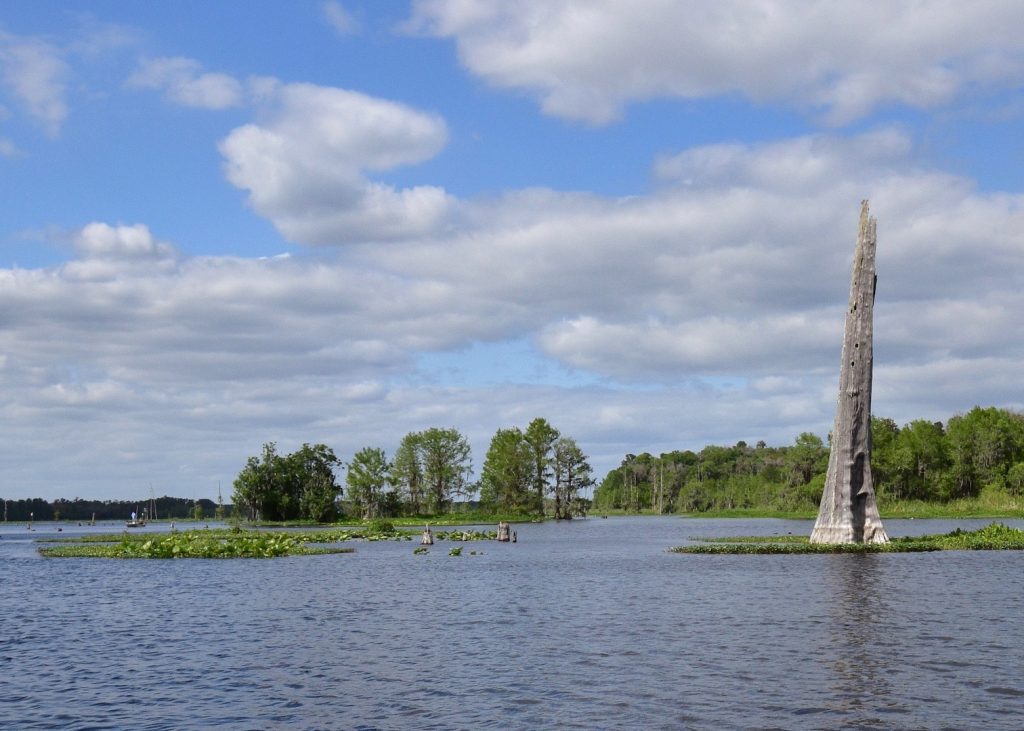
The temperature is in the low 70s, it’s calm and Mark and I both excited because we hadn’t gone shiner fishing in quite some time, as in not since the mid-1990s when we’d hired a different bass guide who’d taken us to two lakes near Orlando, neither of which produced big fish. In fact, they didn’t produce many fish at all.
I feel like a kid as Bob puts a shiner on a weedless hook with a bright orange bobber about a foot above the shiner and throws the hapless minnow into the water. He hands me the rod and says, “All you have to do is watch the bobber. I’ll help with the rest.”
Help schmelp, I’m thinking. We fish all the time during the liquid water seasons in Michigan. This should be easy.
I watch my bobber go left, then right, then back left and under the weeds. Bob suggests I twitch the line a bit to pull the minnow back out so I can see the bobber. I do, and suddenly, the bobber disappears. Bob calmly says, “You have a fish on, so lift your rod and feel the fish.” I do that and don’t feel much of anything. “Now lower your rod and tighten the line, and when it’s tight, set the hook.”
I reel down until I feel tension against the line, make sure my reel is locked down, and yank the rod with my usual great gusto, swinging upwards quickly. I’m awestruck as the shiner and bobber rise swiftly out of the water and into the air in a spectacular arc, past my ear and behind me somewhere on the water.
Fish 1, Amy 0.
Bob looks at me, sighs and says, “That was a big fish.” He takes the rod from me, reels in the minnow, shows me the bite marks on the shiner and says, “And it was a bass. See the bite marks?”
I nod sheepishly. He says, “ You have to wait for the bass to have the shiner in its mouth. This is not reactive fishing like you’re used to. You have to feel the fish on the end of the line by lifting up the rod.” And he shows me how. “If you feel a fish, tighten up the line, reel down until your rod is horizontal to the water and then jerk off to the right real hard.”
I feel like telling him that at least I’d gotten the last part right, but he seems humorless, so I say nothing as he throws my half-eaten minnow into the water and puts on a less traumatized minnow. Bob launches the new minnow out to the weed mass and hands me the pole. “If you ever need to put the rod down, remember to leave it in free spool so that if a fish bites it can just run off with it and not my pole.” I nod.
At that moment Mark’s bobber disappears. He lifts the rod tip, determines there’s a fish on the line, reels up a bit, sets the hook with a grunt…and rips the shiner out of the cover of the weeds, leaving it momentarily stunned on top of the water while the bobber goes flying behind him. The shiner wiggles once and disappears into the water.
Fish 1, Mark 0.
Bob reels in Mark’s bobber and repeats much of what he told me, adding something about “how hard this is going to be.”
Mark and I have fished together since the mid-1990s. We’ve paid guides in Canada, the Amazon, Florida and in Michigan, and Bob is turning out to be the most intense of the guides. But, I think to myself, at least he’s not fishing. Our Lake St. Clair guide had fished all day and out-fished us, all the while telling us our spin casting technique could use some work. Bob has three lines out and keeps handing us what he thinks is the most active pole. He says he has no intention of fishing.
My bobber disappears again, and I’m not sure if it’s because the shiner has pulled its way under the floating weed mass or if I really have a bass on. I lift the rod and it feels like a fish, so tighten up my line, feel a little tension and set the hook…only to bring the shiner and bobber flying out of the water again.
Bob asks me to reel the shiner toward the boat, and he shows me that this time, there are no bite marks on the shiner. He says, “That was all shiner action. Next time, wait until you’re sure. You gotta develop the feel for this.”
“Clearly,” I mumble under my breath.
Score: Fish 2, Amy 0.
A few minutes later, the score is Fish 2, Mark 0. Bob adds another shiner to Mark’s line and tells him, “You just lost a really nice fish.” He walks him through the required motion again, then throws another minnow onto the water. He says, “The fish are biting, so let’s get one!”
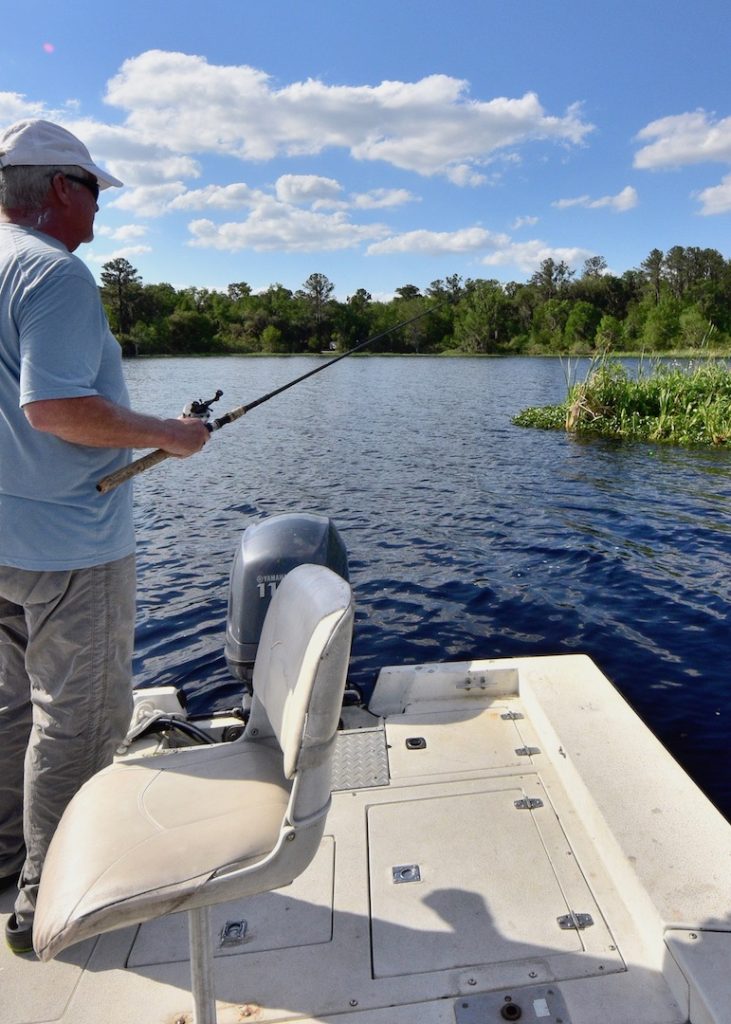
I’m not feeling confident or chatty and I’m very focused on the task at hand. I watch my bobber head out into open water, turn around and head back to the weeds. I pull it away from the weeds a couple of times and the fish keeps going back into the weeds to the same spot. It’s not super fast action, so I figure it’s a good time to try out my new Megabass Grenade—a large squarebill lure. I mean, I’d gotten it for Christmas, and here it was April. I throw it out into open water, reel for perhaps 5 seconds, feel something on the end of the line, smile inwardly, set the hook with great gusto, reel and…and hook into a log. Bob quietly pulls up anchor, takes my fishing pole, hands me one with a minnow on it, and I humbly watch the bobber while Bob maneuvers the boat on top of my lure and removes it from the log. I thank him and tell him I’m done fishing with my stuff. He kind of grunts in response.
Mark is sitting in the front seat when he sets the hook on another fish. Moments after he sets the hook, I find myself unwrapping his line from around my chest. Bob approaches Mark with a look to kill. He takes the rod from Mark, reels it in quickly and shows him the bite marks on the shiner. “That bass couldn’t have been any further inside that bass’ body before you took it away from him.” He goes on again about the steps to successful shiner fishing, and ends by asking Mark to please use his arms to set the hook rather than his body, because, “A previous big guy set the hook with his body while sitting in that seat and broke it.”
Then Bob pats Mark on the back and tells him, “You’ll get this.”
Mark stands, assumes ownership of his new minnow and says nothing. I avoid his gaze because I’m worried he’s not actually enjoying himself.
As I pull my bobber away from the weeds again, I think about Dr. Glenn Pfau, a guy who charges willing governments and other entities a pretty penny to allow a few dozen top-notch staff spend time being broken down in front of their peers and built back up again, all to help improve their communication skills. I’d never suffered through his training—never been told my hair is too long for my age, that I don’t wear enough jewelry (in fact none), and that all my suits are at least five years old–but here I am on Rodman Reservoir getting that same sense of inadequacy while waiting for a fish to bite again. All I could think about was what Mark said out loud: “We’re ruining Bob’s reputation.”
“And to think,” I say, “he’s got us for three full days!”
Suddenly, my bobber disappears under the weed bed. Bob is standing by me and says, “Okay, you have a fish on. Raise the rod tip to make sure.” I raise the rod tip, but I’m still not sure I have anything on. It feels no more significant a tug than the shiner. I tell Bob. He takes the rod from me and raises the rod himself. “That is a bass.” He hands the rod back to me. “He’s moving, so tighten up the line, and keep it tightened as you lower your rod so it’s horizontal to the water, and wham!” I set the hook, my rod bends, I hear him yell, “Reel, reel! You got `em! Keep reeling!” I do as he says and am a strange mix of relieved and excited when Bob plucks a 2-pound bass from the water.
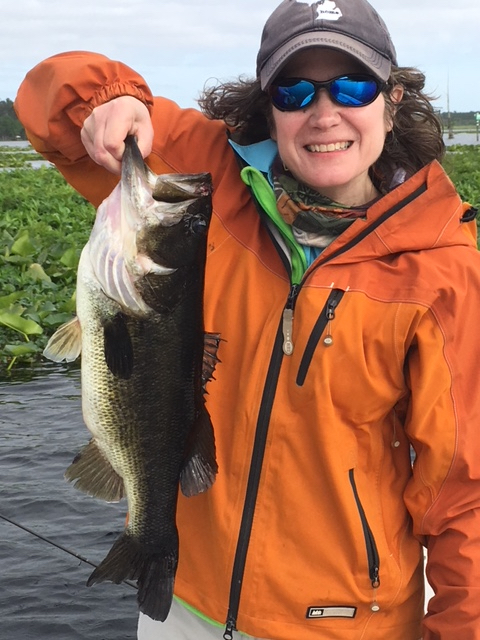
“Yay!” we both say. Mark cheers from the bow.
Score: fish 3, Amy 1.
Bob’s smile is short-lived, though, and as he throws the bass back into the water he says, “You lost a bigger one earlier so let’s put another shiner on and keep going.”
Can you say intense?
Mark’s bobber disappears and Bob is at his side in a flash. “Let it go for a bit.” We all watch as Mark’s bobber goes down and comes back up again in open water, goes down and comes back up again. “He’s being chased,” Bob says, “but it’s all minnow action at this point.” The bobber goes down again—just like it had previously—and this time Bob says, “The bass got it!” Mark reels down, sets the hook and…the bobber goes flying behind him…with the minnow still on the hook.
The look on Bob’s face was one a murderer might have before killing its victim. He looks at Mark and says, “That was a big fish. All it needed was a fisherman at the other end of the line.”
Score: Fish 4, Mark 0. Bob winning, though, due to his amazing comments.
Bob takes Mark’s minnow off, and throws it in the water. Within seconds, an osprey appears above, circles around, circles again and swoops down to pluck the minnow off the water. This same scene would play out numerous times before the day is over. I set my rod down to take photos, making sure, of course, that my line was in free spool.
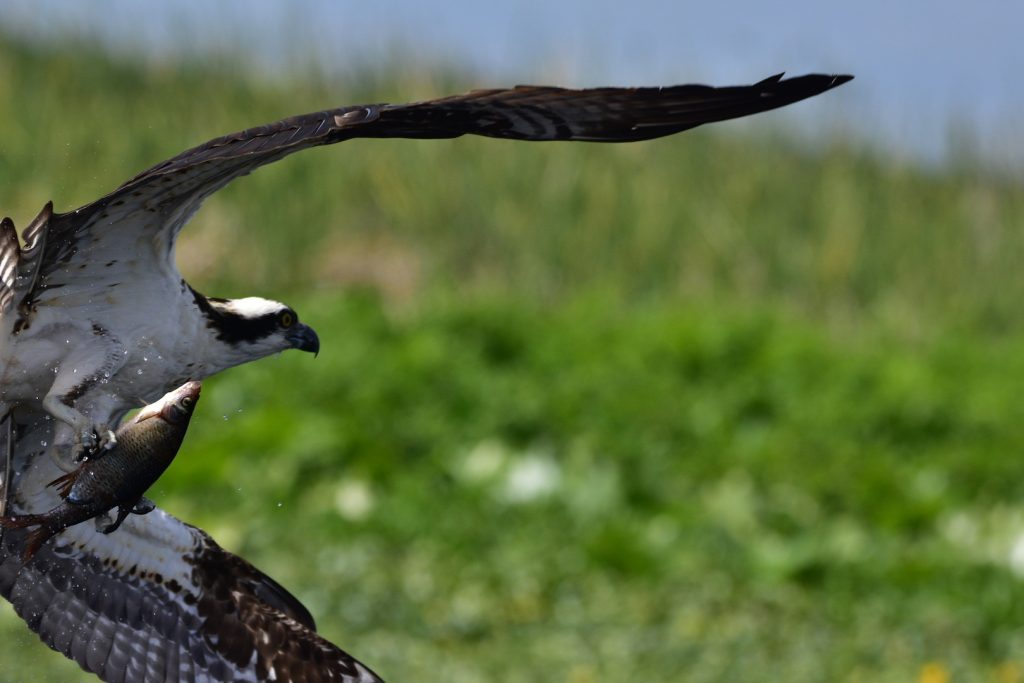
Bob, meanwhile, has put another minnow out for Mark and as he does he says, “Lift the rod up to make sure the fish is there, then reeeeeel down to where your line is tight and the rod is horizontal to the water, THEN yank real hard.”
“But not using your body,” I add.
Mark nods.
Before Bob says it, I say, “You got this.”
I hear the cackle of either a purple gallinule or common moorhen—not sure which, and study the weeds for a moment. A purple bird appears, about the size of a chicken with yellow legs and bright yellow and red beak. I put my rod down and pick up my camera and long lens. As I do, Mark sets the hook on a nice fish and reels it in. I turn back and the purple gallinule is gone, so twist off my zoom lens and put on the fish-eye lens to capture a photo of Mark’s bass. It’s perhaps 4 pounds, and Mark is all smiles and so is Bob as I take photographs. I put the camera down, pick up my rod and see my bobber has disappeared under the weeds. I lift the rod, feel nothing–in fact, less resistance than any time before. Reeling in, I discover my minnow is gone.
“What happened?” Bob asks.
“I got robbed while trying to photograph a purple gallanule and then Mark’s fish.”
“Are we fishing or are we not?” he asks.
Mark says, “She likes taking photographs, too.”
I point to my Nikon 7200 and its 10-inch lens.
“Oh, well, hm,” he says. “Most people don’t know what a purple gallinule is.”
Score: Fish 4, Purple Gallinule 1, Amy 1, but feeling better.
“Okay,” Bob says, “we had a double, so let’s see if we can do that again. But first, we’re going to move to another spot.”
Bob sprints to the bow and lifts the anchor with ease, which is impressive given he’s 70 like Mark, born in September, like Mark, and just a few days older. He puts the boat into gear and zooms us past a few triangular signs to another spot. He drops anchor, and seconds later, we hear what sounds like an echo of the anchor splash. I ask Bob what the noise was and he says, “We spooked a big gator.”
I mention how when fishing in the Amazon, we had to reel small peacock bass quickly back to the boat, because caiman were often nearby and sometimes pursued the caught fish. He says gators don’t tend to do that. I keep looking around for the big fella and it’s not until later in the day that we see one. It looks like it would measure 12 feet.
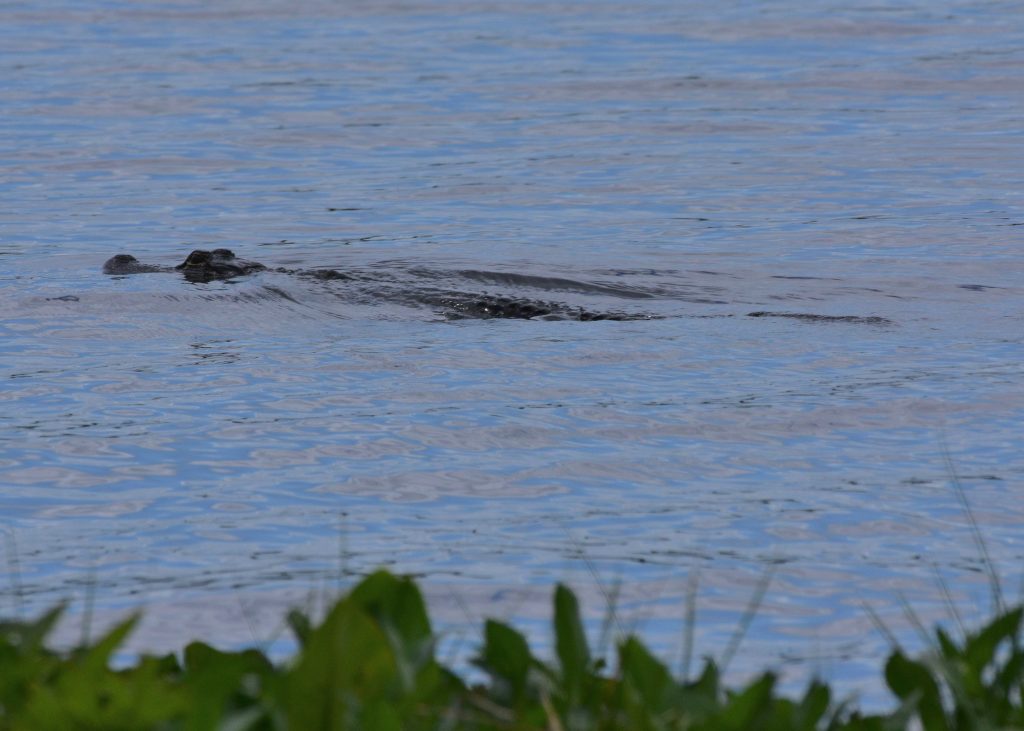
While the gators are not interested in our fish, the osprey have caught onto the fact that there are two boneheads from Michigan who have developed the habit of yanking perfectly good minnows out of the water, into the air, and back in the water again, and who don’t pay as much attention as they should when their minnows are in open water. I say that because as one of my minnows is taking a cruise across open water, an osprey circles over, notices the action of my bobber, swoops down and takes my shiner right out from under the bobber.

Bob is beside me in a flash and says, “You’ll have to jerk that line right when the osprey swoops to keep it away from them.” He throws out another shiner, ensuring it lands near the bed. Like the previous shiner, this shiner heads to open water, and as it does, another osprey circles. just as it swoops down, I jerk it away, and, for good measure, say, “No! Bad osprey!”
Fishing is steady all day, and we eventually start getting the hang of shiner fishing. We’ve each landed 10-15 fish, and I’m feeling pretty good about things when my bobber jerks suddenly away from the weeds to open water and goes under water. I lift the rod, feel tension, start winding up on a fish that’s hell bent to continue heading to open water, when it suddenly starts coming towards the boat. I keep winding, hope it’ll stop before it gets to the boat, it does not, so I bend over, wind up and jerk…and the float ends up behind me. I wait for the scolding, and Bob says, “You did that just right. Not much more you could have done that time.”
Moments later, we are watching our bobbers when mine suddenly shoots off to the right and disappears. It pops up and reappears for a brief second, then goes down again and line starts spooling freely. I pick up my rod and feel the tension as the bass heads off to the right. I lower the rod, reel up the slack and wham! Bob gets the net this time, and I know I have a big fish. I reel and reel and bring the biggest bass of my life to the boat. Bob nets it with ease. He goes “Yay!” and gives me a fist thump. We photograph my fish and weigh it: 8 pound 14 ounces.
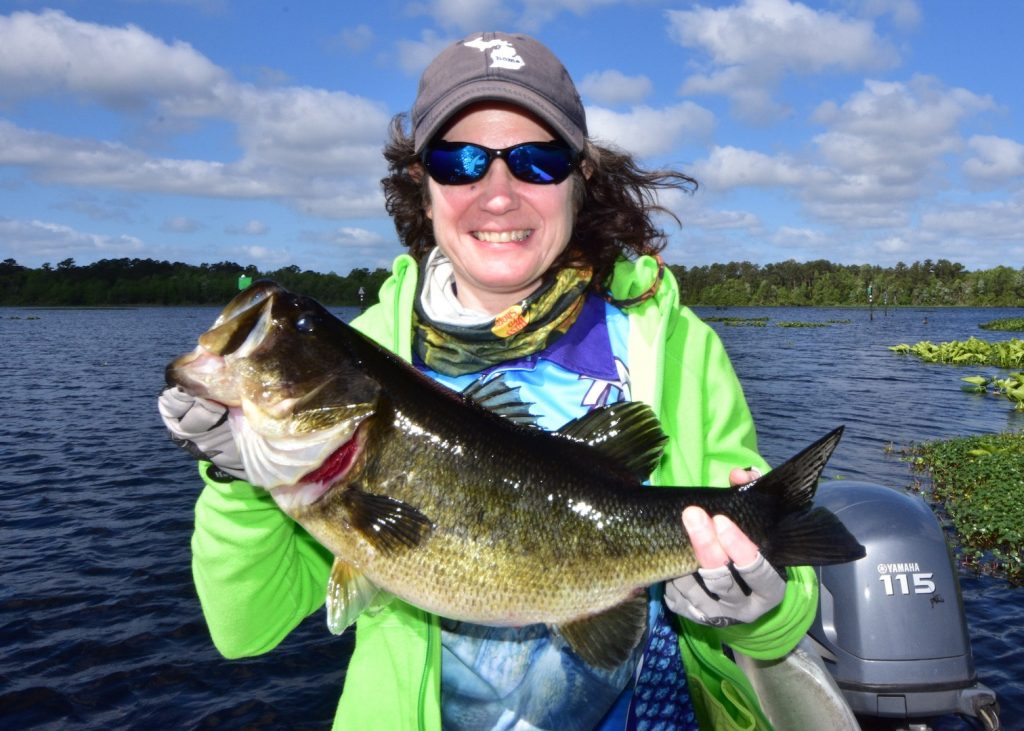
I’m happy as can be…until Bob informs me I’m not holding the fish right.

I am also kind of bummed for Mark, because it was on his bucket list to catch a 10-pound bass and I’m the one with the largest fish of the day. His largest fish of the day is perhaps 7 pounds, Bob guesses, but we don’t weigh it.

Bob calls it a day around five and says that Mark and I had used about 5 dozen minnows and each landed 15 or so fish each. Mark says our hook-up rate was pretty miserable. I mention that the ospreys got at least 5 minnows, so at least they are well fed.
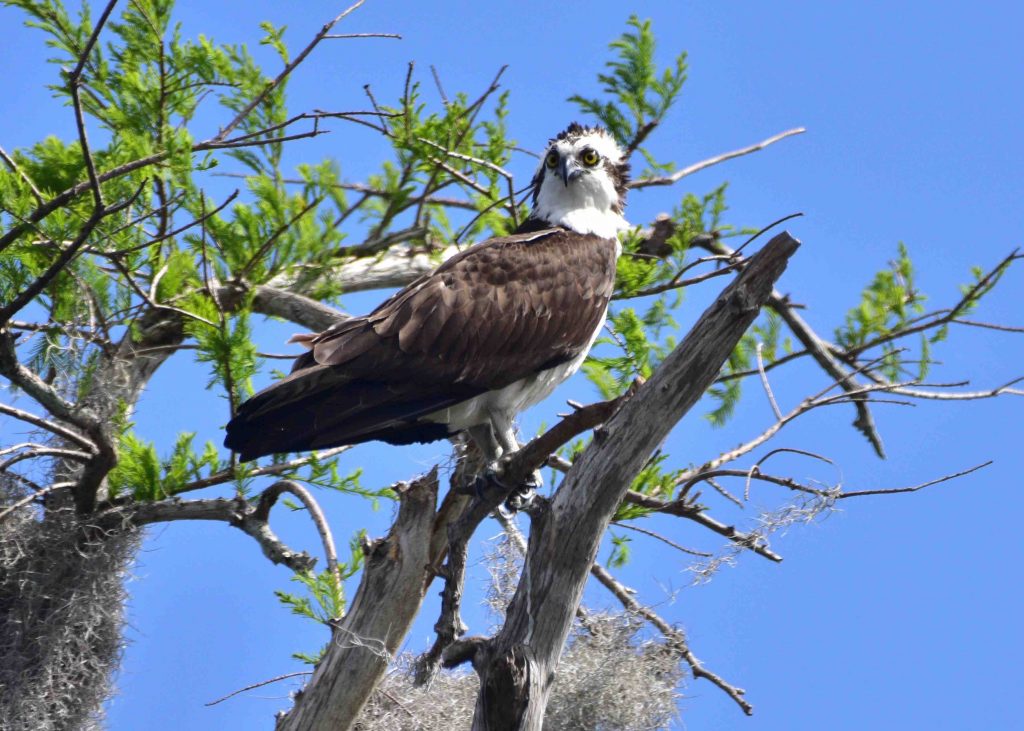
On our hour and half drive back to the motel, Mark and I reflect on our humbling day. We come to the conclusion that Bob is solely and singularly focused on helping people land big fish. His intensity is because he wants us to be successful. So, in spite of feeling at times completely inept, we agree we couldn’t have picked a better guide.
We wrap up our day with Popeye’s for dinner, because we are too tired to look for anything else. Mark gets his fill of spicy chicken and I eat a box of fried shrimp. We drift off to sleep wondering if we’ll ever really get the hang of shiner fishing. And whether Bob will show up tomorrow.